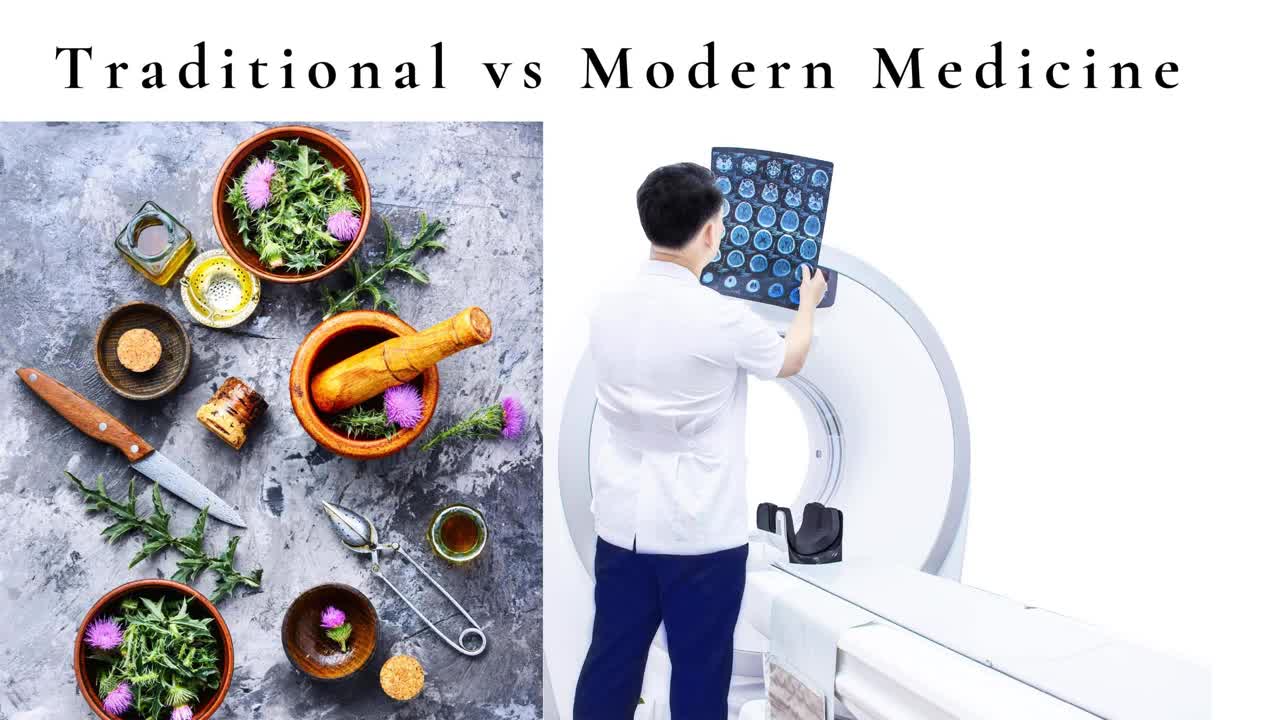Premium Only Content

Traditional vs Modern Medicine
Traditional vs Modern Medicine; where do I begin? Some of you are new and I want to welcome you to the show. I hope you enjoy the content and will share with others. For my regulars, you’re probably wondering where I have been. I’ve missed doing the podcast but it became impossible for me to continue because my health took a very bad turn. I just had a bout with a perforated appendix and associated abdominal infection. I’ll get to all of that. Today I’m going to contrast traditional medicine with modern medicine. Stay tuned.
Today’s Show
• Homestead Life Updates
• Modern Medicine vs the Traditions in Pre-Modern Medicine
• Home Made Yogurt Recipe
Homestead Life Updates
Life on the homestead has been chaotic at best. It is starting to settle down now that I am out of the danger zone and on a path back to health. But Scott has had to take up the slack. And then, there are some things that just didn’t get done.
Scott has been doing all of the milking without my assistance since about the first of August. That is nearly a month now. His morning chores have lengthened from a couple of hours to 3 plus. That takes a big bite out of his day but he is taking it in stride. You do what you gotta do as they say.
The Baby Quail
He built the “grow out” cage for the baby quail. I don’t think I’ve even mentioned them. I’m pretty sure that the last you heard was the eggs were still in the incubator, right? I became ill the very day they hatched out. It was also the day that I would normally record the podcast. The quail and I share that anniversary. Their birth date and the start of my appendicitis. Anyway, they were in the brooder for about two weeks. We kept them inside under a light the first week. The light keeps them warm as they have down but no feathers when they are born. Their growth is phenomenal. Within a week they more than double in size and become nearly fully feathered. By the end of the second week, they are tripled in size or more. The brooder space gets really small for them. And the shear amount of waste they create in that small space will stink up the place. At two weeks they are ready to be outside.
The Quail Condo
Scott built a second story onto the quail cage and put the new ones on top. There are two large sections up there and lots of space for them to roam around in. The laying hens and their roosters are below. There are three sections there with three sets of hens with a rooster. Some of the new babies will become laying hens and the rest will go to freezer camp. We don’t have chickens yet, so my plan is to raise up a batch of quail every couple of months. That will provide us with poultry. My freezer has been bare of poultry for a very long time. Occasionally I will buy one of those rotisserie chickens at the grocery store for a treat, but mostly we have been doing without. We have lots of lamb, beef, and goat for our protein source.
What about fish you say? Well, we have fish in the pond but no time to fish. That will come even later. At the moment, we rarely have fish. It’s a treat that I just might fix tomorrow night.
Cows, Sheep, Goats
I don’t have much to say about the animals because we haven’t talk much about them. As Scott has not reported any issues, I assume they are all in fine shape and doing their duty. Eating grass and making milk. Soon it will be time to breed the sheep for their spring lambing. Oh, we did separate the ram lambs. I say “we”. How funny. Scott did it. Ten lambs were born on the homestead this year. Five of them were boys. They are now happily grazing with the older boys from last year and the herd ram. They have lost most of their cuteness but are still a joy to watch as they live their lives out there in the pasture. Currently I can see them out my living room window.
The Garden
The garden is a giant weed bed. The tomatoes, celery, sweet potatoes, and eggplant were dying of thirst for the most part. They have survived the ordeal and Scott was able to give them more attention after I was released from the hospital. Even with the drought, we have lots of tomatoes. I think I might have been overwhelmed had I been able to keep them watered. We would have had lots of tomatoes and they would have been big tomatoes. The ones we have now are definitely stunted, maybe 2 ½ to 3” in diameter at best. Many are even smaller but tuning red anyway.
What am I doing with all of those tomatoes you ask? I’m making tomato sauce. It’s actually a fairly simple process if you have the right tools – which I just happen to have. I’ll give a very brief outline of the process. Perhaps I will make a whole podcast on making tomato sauce at a later time.
Making Tomato Sauce
The first two steps involve getting the skins and seeds out. I simply cut the tomatoes into quarters or sixths or eighths depending on their size. I throw them into a pot on low heat. The water comes out quickly so there is no need to add water. Once they come to a boil, I let them simmer for 20 minutes or so. Then I let that cool for at least a couple of hours. It makes it easier to work with for the second step.
Now I’m ready to do the separation. This is where the proper tools are required to make it easy. There are lots of ways to do it, but I prefer the least effort and smallest mess. I have a Kitchen Aid mixer and the food mill attachment. I put the pieces together, feed the tomatoes through the mill and voila, tomato juice and pulp are separated. I did some yesterday and it took about 20 minutes to mill nearly 4 gallons.
The next step will begin tomorrow. I need to cook out the liquid until it becomes the consistency that I want for my sauce. Again, an easy process. Put it on the stove on low heat and stir it occasionally. Once it reaches the proper consistency, I ladle it into the jars I have prepared for canning. The jars get sealed and placed in a hot water bath for 15 to 20 minutes depending on the size of the jar. That’s it! Homemade tomato sauce. I’ll do a whole podcast on the details for those that want to try this for themselves.
I want to keep this podcast as short as possible as my energy level has a strong tendency to drop through the floor without a moment’s notice. I still have lots of healing to do. So what happened? And how did I deal with it?
Modern Medicine vs the Traditions in Pre-Modern Medicine
The dilemma between tradition vs modern medicine is a question I come across often. When I first became ill, I worked with what I had available to me at home that I could do without becoming involved in modern medicine. There were two reasons for this. Number one, I’ve always been able to do this without issue and number two, we have no insurance and modern medicine can be really expensive.
It started on a Saturday and I was in really bad shape on Sunday morning. My self-diagnosis said that I was trying to pass a kidney stone. After all, I had had the experience a few months earlier and I got through it without much trouble. Now I wonder if the earlier episode was really a kidney stone. I’ll never know now. The symptoms were so similar.
Kidney Stones?
Initially Scott thought it was a problem with my colon but I was adamant that it had to be another kidney stone and I just needed to get through it. When the fever started, we got out the antibiotics that we keep on hand for just such an emergency. That brought things somewhat under control quite quickly. However, I was still in a great deal of pain and quite weak and unable to do anything. This went on for a week. Then my fever spiked again. Of course, it was Sunday and I didn’t want the expense of the weekend emergency room. I did, however, decide that this was now outside of my realm of expertise. The infection and fever were overriding the antibiotics and I knew it was likely I was going to have to have stronger antibiotics at the very least and likely IV antibiotics.
Nope. Appendicitis.
Monday after Scott finished morning chores we went to a clinic in Mount Airy. I got blood tests and a chest x-ray. After getting the results it was off to the ER for further evaluation and treatment. My white blood cell count was extremely high. That led to lots of expensive tests and a very expensive CT along with a move to Winston-Salem and 3 days in the hospital. It was bad. I had a perforated appendix with an associated abscess. Lots of infection. Before modern medicine I likely would have died. It’s the old “burst appendix” scenario that has always scared people. There is good reason for that.
Recovery
I am still very weak and have been told that it may last for 2 months. That is a long time for a farm girl and homesteader. Thankfully, we have wonderful friends and family who have prayed for us and offered real assistance as well. We will get through this difficult time. I’m sure most of you have had similar times. While it is going on I feel like it will never end. But it will end, I will recover and life will go on with many new lessons learned.
For a very long time I have been aware of the wonders of modern medicine. I have studied ancient healing techniques. During the early 2000s I even studied formally and received higher education degrees in Natural Health and Naturopathy. Herbs were my passion for much of that time. I developed my own herbal recipes for general hearth health, immune system support and a sleep aid that was a lifesaver for me for many years. I still use these products as well as others. They have their place in my health and wellbeing. But the awareness of my limitations has always been part of my knowledge base.
Modern Medicine
Many would say that I waited too long and should have sought medical attention earlier, and that may be true. But I can’t see that I would have done anything differently. It seemed harmless at the time. Who would have thought of appendicitis at my age? Well, it is true that it can happen at any age, but it’s usually something that happens before age 30. But you know statistical numbers group things into averages. With any “average” there is a high end and a low end, thus we know that, while it is more unusual, it is not unheard of to draw that appendicitis card at any age.
Some of you may frequent Facebook groups that are about one aspect of health or another. Perhaps a specific diet group like Keto. I belong to lots of those groups. I also belong to lots of farm animal groups and some farm business groups. With all of these, there will be a smattering of traditional medicine techniques that are put forth for consideration during appropriate questions and health discussions. And then there are the times when the group responds with “go see your doctor”. Or “contact the vet” in the case of animals. Sometimes we simply don’t have the skills, tools and experience necessary and must call on professional help.
When to Use Traditional Medicine
When and if to use traditional vs modern medicine can be a touchy subject in the homesteading community as most are trying to be as self-sufficient as possible. But I just can’t state it enough times, sometimes you need modern medicine to continue living. Your animals need it. All of the traditional home remedies in the world fail to meet the need at some point and embracing the best available technology is the only answer. Inevitably the result is mostly painful. Whether financially or physically.
Here’s an example. The fact that the treatment causes some injury is the price we sometimes have to pay to return to health. I thank God every day that I did not have to have emergency surgery. Talk about damage to the body in order to keep it alive. That’s the extreme. You are literally cutting flesh to get to the problem. That flesh now has to heal and is added to the original problem.
Re-Growing Gut Bacteria After Antibiotics
I got away with a small tube in my side for a couple of weeks and an enormous amount of antibiotics. Did I like the amount of antibiotics I just received and ingested? Heck no. My guts will need lots more healing that my traditional methods will be able to provide. I know about probiotic foods. Homemade yogurt is in my diet for the next few weeks to help my gut bacteria return to normal. We shall see. It may be a couple of months. Who knows? I didn’t like it. I was nauseated day after day because of the two strong antibiotics I was on for a full two weeks after the IV antibiotics were stopped. Thankfully, that is finally over. I’m going to go have some yogurt right after I finish this. I like yogurt, but I don’t “love” yogurt. I’m pretty sure it is going to get old quickly. But I will persevere and give my body the traditional support that is needed after modern medicine has kept me alive.
How about this week’s recipe on how to make your own yogurt? You don’t have to have our wonderful raw milk for this. You can make it with any milk from the store that is not ultra-pasteurized. Unfortunately, most organic milk is ultra-pasteurized and will not work. It’s still worth it to use conventional milk to have your own yogurt without artificial sweeteners and thickeners.
Home Made Yogurt
I make mine in my Corsori multi-function pressure cooker. It has a yogurt setting. I believe it would be similar with the Instant Pot or any other multi-function pressure cooker with a yogurt setting. You don’t have to have one. I also have a rather inexpensive yogurt maker. The reason I no longer use it has to do with how much yogurt I make in one batch. The small, inexpensive yogurt maker works for a quart or two. But I make a gallon and a half at a time now. Yogurt will last a very long time in the refrigerator.
So what do you need? Ultimately, what you need is a way to keep the temperature constant between 110 and 115 degrees for anywhere from 4 to 8 hours. That’s why all the fancy equipment is sold. It makes it easy. You don’t have to baby sit it while it ferments. Just set it and walk away.
Your Oven
You can use the pilot light in your oven. Better still would be to preheat your oven to 120 or so, then turn it off. Wrap your milk with its yogurt culture in towels and use the oven’s retained heat to keep the temperature up. Placing a baking stone in there will also help hold the heat.
Using a Thermos
Another method is to use a thermos. Some of the best cost as much or more than a cheap yogurt maker but, of course, the thermos would have more uses. And you may already have one on hand. No need to purchase anything extra. Come to think of it, I have a thermal cup that I bought to keep my tea hot over long periods of time. It’s one of those that you can buy at your local gas/convenience store or truck stop. That cup holds nearly a quart of liquid and will keep it hot, and I mean hot, for hours. That’s modern technology for you. You might have one or two of those on hand and, again, no need to purchase anything extra.
A Warm Corner
The last method I will mention is trying to use a warm part of your kitchen or other place in your house during the summer. This would require experimentation and keeping a consistent temperature would be dicey at best.
Crock pots get too hot. Don’t try that. Even the lowest setting is over 150 degrees. That will kill the yogurt bacteria. I’ve seen people give recipes using a crock pot and maybe they have a special one, but all of mine even on warm are heating way too hot for yogurt culture to survive.
Let’s get on to the basics of making yogurt.
What You Need
• Full fat milk
• A small amount of yogurt with active cultures
What to Do
• Heat the milk to 180 degrees. This destabilizes the proteins in the milk which makes the yogurt thicken nicely.
• Quickly cool the milk to about 118 degrees.
• Stir in the yogurt with active cultures with a small amount of the milk to make sure it is incorporated well.
• Add the active culture yogurt and milk to the rest of the milk, stir well.
• Set it in your chosen place to keep it warm for 6 to 8 hours.
Notes
• If using the multi-function pressure cooker, use the slow cook setting to heat the milk. On my Corsori, I set it to 193 degrees for 1 hour. As soon as the hour is up, I check the temperature which is usually 180 something by then. I immediately take it to the kitchen sink and fill the sink with cold water. It only takes 5 minutes or less to cool it back down. Then once the cultures are stirred in it is a matter of putting the pot back in the device, closing and securing the lid and pressing the “yogurt” button. Mine is automatically set for 8 hours, though I could take it out sooner if desired. It’s so easy.
• Using a saucepan on the stove is also an option for heating the milk. In this case, stay nearby to stir often so the milk does not scorch on the bottom of the pan. This requires a little more attention, but it still quick and easy. Once 180 or more degrees is reached, put in the pot in the kitchen sink with cold water to quickly cool it down. Add the yogurt with active cultures and mix well. Now use your desired device or method.
• The longer your yogurt sits, the sharper it will be. It will also be thicker if it cultures longer.
• For thicker, Greek-style, yogurt strain it through butter muslin. Line a colander with the butter muslin and pour in the yogurt. Tie the ends together and hang your makeshift bag somewhere to drain. This will allow some of the whey to be filtered out and will make a much thicker yogurt. The longer it drains, the thicker it will be.
Final Thoughts
That’s it for today’s podcast on traditional vs modern medicine. I’m so glad to be back. And I’m so glad you are traveling along with me. We all have great adventures in our lives. Please share your thoughts, your ideas, and your adventures in the comments. What are you doing on your homestead if you have one? What are your plans if you don’t have a homestead but want one? What are your plans for making friends with your local homestead community if you don’t want one but love that others do because they provide great food and recreation for you and your family?
I’d love to hear your thoughts. And if you’re up to it, how about giving some homemade yogurt a try? Or if you’d prefer coming here to learn how, let me know that as well. I’d love to offer some classes in some of the homestead arts.
Lastly, if you’d like to help us out in our time of need, you can donate to this podcast via our website at www.peacefulheartfarm.com/donate. The very best thing you can do is share this podcast with others that you think might enjoy it. That helps us with getting higher rankings in the podcast search algorithms. I appreciate you all so much.
As always, I’m here to help you “taste the traditional touch.”
Thank you so much for listening and until next time, may God fill your life with grace and peace.
Recipe Link
Home Made Yogurt
To share your thoughts:
• Leave a comment on our Facebook Page
• Share this show on Twitter, Facebook and Instagram
To help the show:
• PLEASE LEAVE A REVIEW for Peaceful Heart FarmCast on Apple Podcasts.
• Subscribe on Apple Podcasts, Stitcher Radio, Google Play Music, TuneIn or Spotify
• Donate on Patreon
Website
www.peacefulheartfarm.com
Patreon
www.patreon.com/peacefulheartfarm
Facebook
www.facebook.com/peacefulheartfarm
Instagram
www.instagram.com/peacefulheartfarm/
-
 LIVE
LIVE
Viss
1 hour ago🔴LIVE - PUBG Solo Tactics To Win Consistently! - PUBG 101
75 watching -
 2:05:54
2:05:54
Steven Crowder
4 hours agoLive Reaction: RFK Faces Senate Grilling After Employees Demand His Resignation
196K179 -
 1:02:58
1:02:58
The Rubin Report
3 hours agoPress Stunned by Trump’s Brutally Honest Message for Elon Musk
26.9K38 -
 LIVE
LIVE
Rebel News
48 minutes agoPolice chief says 'comply' with intruders, Carney on temp workers, Trump on tariffs | Rebel Roundup
314 watching -
 DVR
DVR
Neil McCoy-Ward
1 hour ago🚨 Hospitals Are Bracing For MASS Casualties...
7.84K1 -
 LIVE
LIVE
The Mel K Show
2 hours agoMORNINGS WITH MEL K - NATO Cognitive Warfare & Post WWII Betrayal Finally Exposed 9-4-25
821 watching -
 LIVE
LIVE
The Shannon Joy Show
4 hours agoCOVID Not A ‘Lab Leak’, It Was Created At UNC Chapel Hill! LIVE - Exclusive With Dr. David Martin
307 watching -
 LIVE
LIVE
LFA TV
6 hours agoLFA TV ALL DAY STREAM - THURSDAY 9/4/25
3,810 watching -
 59:56
59:56
Grant Stinchfield
2 hours agoGas Prices Broke Him – Newsom Quits the Fight!
3.51K6 -
 59:38
59:38
Trumpet Daily
1 hour agoTrumpet Daily LIVE | Sept. 4, 2025
10.8K3